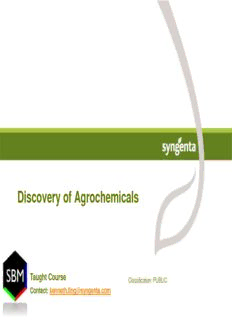
Introduction to agrochemicals and modern agronomy PDF
Preview Introduction to agrochemicals and modern agronomy
Discovery of Agrochemicals Taught Course Classification: PUBLIC Contact: [email protected] Syngenta at a glance $1.4 billion $15.1bn R&D investment in 2014 and Over 5000 sales in 2014 28000 more than R&D staff employees 90 in some countries 2 Classification: PUBLIC Syngenta R&D locations Jealott’s Hill, UK Major R&D sites Herbicide Chemistry located on Biological Sciences three continents Formulation Process Studies Greensboro, Product Safety USA Formulation Beijing, China Environmental Science Biotechnology Natural Products Chemistry at various Chinese Universities SBI, Goa, India Research Triangle Research Park, USA Chemistry Biotechnology Stein, Switzerland Kilo Lab R&D Process Research Chemistry and Biology: Fungicides, Insecticides & Seed Care 3 Classification: PUBLIC Introduction to agrochemicals and modern agronomy Taught Course Classification: PUBLIC Our Fundamental Challenge 2050 By , global population will rise by about 9 billion a third to people but Global calorie demand will increase by 50% Oxford Population ~150k A city the size of Oxford every 16 hours Source: Food and Agriculture Organisation (UN), World Bank statistics, Syngenta 5 Demand for food is driven by population growth World population World demand for grains* (as per FAO) >80% of growth happens in emerging markets Food 2050 Feed 9 billion Developed bn tonnes Emerging 4 +50% 2011 7 billion 3 2 1950 2.5 billion 1 0 1970 1990 2010 2030 2050 Source: FAO, Syngenta analysis * Includes cereals, rice, corn, excluding oilseeds 6 CCllaassssiiffiiccaattiioonn:: PPUUBBLLIICC Changing diets impacts on grain demand Increased wealth in developing countries leads to higher protein content and higher calorie diets This impacts demand for agricultural feed: Per kg of meat, production requires this much grain: 2kg 4kg 7kg Source: International Food Policy Research Institute and FAO 7 Classification: PUBLIC Demand 8 Classification: PUBLIC Limited land for agriculture About a third of global land surface is agricultural, but only 12% is for crops Little land for further expansion and limited resources (water, soil nutrients) How do we meet growing demand? 9 Classification: PUBLIC Geographical distribution of agricultural land Source: National Geographic 10 Classification: PUBLIC
Description: